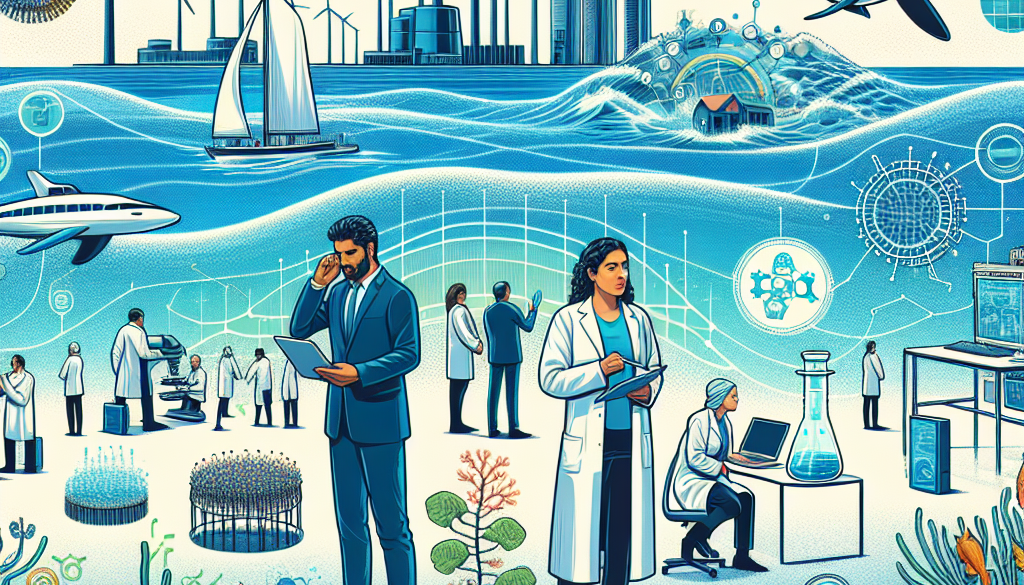Emerging Technologies Driving The Blue Economy
-
Table of Contents
- Emerging Technologies Fueling the Blue Economy Revolution
- Marine Biotechnology and Genetic Resources
- Renewable Marine Energy
- Advanced Aquaculture Technologies
- Autonomous and Remote-operated Vehicles
- Big Data and AI for Ocean Management
- Conclusion
- ETprotein: Enhancing the Blue Economy with Sustainable Protein Solutions
Emerging Technologies Fueling the Blue Economy Revolution

The Blue Economy encompasses a broad spectrum of economic activities related to oceans, seas, harbors, and coastal zones. It is an emerging concept that encourages better stewardship of our ocean or ‘blue’ resources. As the traditional maritime economy evolves, emerging technologies play a pivotal role in driving sustainable growth. This article delves into the innovative technologies that are propelling the Blue Economy forward, ensuring the conservation and sustainable use of ocean resources for economic growth, improved livelihoods, and jobs while preserving the health of the ocean ecosystem.
Marine Biotechnology and Genetic Resources
Marine biotechnology is a frontier technology that holds promise for the Blue Economy. It involves the exploration and manipulation of marine bio-resources to develop new products and processes. With the ocean being home to a vast array of biodiversity, marine biotechnology can lead to breakthroughs in pharmaceuticals, food production, and even biofuels. Genetic resources, such as unique enzymes and biomaterials derived from marine organisms, have the potential to revolutionize industries by offering sustainable alternatives to traditional materials.
- Development of new medications from marine organisms
- Advancements in sustainable aquaculture feeds
- Production of biofuels from algae
Renewable Marine Energy
Renewable marine energy is a critical component of the Blue Economy. Technologies harnessing the power of waves, tides, and offshore wind are becoming increasingly viable as a means of reducing carbon emissions and providing clean, reliable energy. Offshore wind farms, for example, are expected to grow significantly, with the Global Wind Energy Council forecasting a 15-fold increase in capacity by 2040.
- Wave energy converters capturing energy from ocean waves
- Tidal stream generators utilizing underwater currents
- Floating solar panels on reservoirs and coastal areas
Advanced Aquaculture Technologies
Aquaculture, or fish farming, is an essential part of the Blue Economy, providing a sustainable source of seafood. Emerging technologies in this sector aim to increase efficiency and reduce environmental impacts. Innovations such as recirculating aquaculture systems (RAS) allow for water reuse, reducing the need for fresh, clean water and minimizing waste. Precision aquaculture uses sensors and AI to monitor fish health and optimize feeding, leading to healthier fish and reduced feed costs.
- Recirculating Aquaculture Systems (RAS) for water conservation
- Automated feeding systems using IoT technology
- Genetic selection for disease-resistant and fast-growing fish species
Autonomous and Remote-operated Vehicles
Unmanned systems such as Autonomous Underwater Vehicles (AUVs) and Remotely Operated Vehicles (ROVs) are transforming ocean exploration and monitoring. These technologies enable researchers to collect data in previously inaccessible areas of the ocean, improving our understanding of marine ecosystems. They also play a crucial role in the maintenance of offshore infrastructure, such as wind turbines and underwater pipelines.
- AUVs for deep-sea exploration and environmental monitoring
- ROVs for maintenance and repair of offshore structures
- Autonomous surface vessels for maritime surveillance and cargo transport
Big Data and AI for Ocean Management
Big data analytics and artificial intelligence (AI) are becoming indispensable tools for managing the Blue Economy. They enable the processing of vast amounts of oceanographic data to inform decision-making in areas such as sustainable fishing, shipping route optimization, and climate change mitigation. AI algorithms can predict patterns and trends, leading to more effective conservation strategies and emergency response planning.
- AI-driven predictive models for fish stock management
- Machine learning for identifying illegal fishing activities
- Data analytics for optimizing shipping routes and reducing fuel consumption
Conclusion
The Blue Economy is at the cusp of a technological revolution, with emerging technologies offering unprecedented opportunities for sustainable ocean-based industries. From renewable energy to advanced aquaculture, autonomous vehicles to big data analytics, these innovations are setting the stage for a more sustainable and prosperous relationship with our oceans. As we continue to explore and harness these technologies, it is crucial to ensure that they are deployed responsibly, with a focus on preserving marine ecosystems for future generations.
ETprotein: Enhancing the Blue Economy with Sustainable Protein Solutions
In line with the sustainable ethos of the Blue Economy, ETprotein offers a range of high-quality organic bulk vegan proteins that cater to various industries. Their products, including Organic rice protein, clear rice protein, pea protein, and more, are characterized by a neutral taste, non-GMO, and allergen-free attributes. ETprotein’s commitment to sustainability and quality makes them an ideal partner for businesses looking to incorporate environmentally friendly protein solutions into their offerings.
About ETprotein:
ETprotein, a reputable protein and L-(+)-Ergothioneine (EGT) Chinese factory manufacturer and supplier, is renowned for producing, stocking, exporting, and delivering the highest quality organic bulk vegan proteins and L-(+)-Ergothioneine. They include Organic rice protein, clear rice protein, pea protein, clear pea protein, watermelon seed protein, pumpkin seed protein, sunflower seed protein, mung bean protein, peanut protein, and L-(+)-Ergothioneine EGT Pharmaceutical grade, L-(+)-Ergothioneine EGT food grade, L-(+)-Ergothioneine EGT cosmetic grade, L-(+)-Ergothioneine EGT reference grade and L-(+)-Ergothioneine EGT standard. Their offerings, characterized by a neutral taste, non-GMO, allergen-free attributes, with L-(+)-Ergothioneine purity over 98%, 99%, cater to a diverse range of industries. They serve nutraceutical, pharmaceutical, cosmeceutical, veterinary, as well as food and beverage finished product distributors, traders, and manufacturers across Europe, USA, Canada, Australia, Thailand, Japan, Korea, Brazil, and Chile, among others.
ETprotein specialization includes exporting and delivering tailor-made protein powder and finished nutritional supplements. Their extensive product range covers sectors like Food and Beverage, Sports Nutrition, Weight Management, Dietary Supplements, Health and Wellness Products, and Infant Formula, ensuring comprehensive solutions to meet all your protein needs.
As a trusted company by leading global food and beverage brands and Fortune 500 companies, ETprotein reinforces China’s reputation in the global arena. For more information or to sample their products, please contact them and email sales(at)ETprotein.com today.












